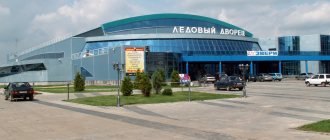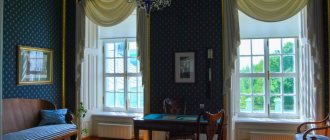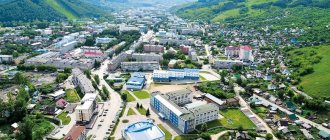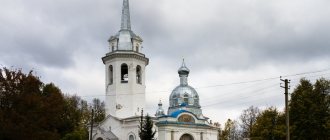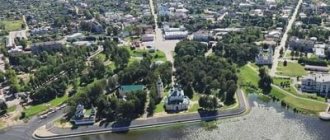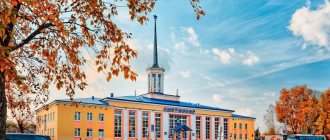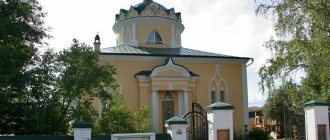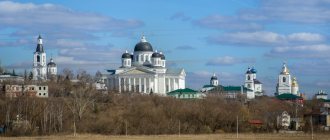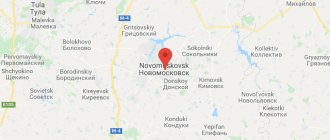Dmitrov is one of the most beautiful cities in the Moscow region: the hills of the Klinsko-Dmitrovskaya ridge, the Moscow canal, the ancient Kremlin, temples and monasteries, ancient houses and estates... In this small guide, compiled on the basis of our own numerous trips to Dmitrov and the Dmitrovsky district (now Dmitrovsky city district), I will try to talk about what, in my opinion, deserves attention here.
Dmitrov Kremlin and monument to Yuri Dolgoruky
Dmitrov Kremlin
Hidden inside the Dmitrov Kremlin is a picturesque monument to Cyril and Methodius.
The pearl and the city center. This is not a Kremlin in the traditional sense, but a huge rampart about a kilometer long and almost 10 meters high. In the 12th century, the monumental structure served as a fortress and protected residents from raids. A log wall with towers was built on the rampart, which has not survived to this day. Now this is a favorite place for Sunday walks for residents and tourists. Climb to the top of the rampart with your children, have a picnic and watch the sunset.
Be sure to go to the western entrance, where the Nikolsky Gate is located. This is the remaining part of the Kremlin wall, which stood until 1610. It regularly burns and is restored, so it is not an original, but a replica.
Inside the rampart you can take a walk with your children along the cobblestone street and look for a “wishing stone” with a broken horseshoe. It was here, according to legend, that Yuri Dolgoruky’s horse stumbled. Admire the monuments and relax on the cast benches near the Assumption Cathedral. You can visit the temple on your own or use the services of a guide.
Dmitrov's story
People have long settled in these areas, as evidenced by numerous mounds, fortifications and sanctuaries. Dmitrov is not much younger than Moscow - Prince Yuri Dolgoruky founded it in 1154 on the site of an ancient Slavic settlement and named the city in honor of his son Vsevolod (baptized Dmitry) who was born that year. The location was chosen well: near the Yakhroma River, from where the trade route to the Volga went along Sestra and Dubna. Another, land route went to Klyazma, and from there to Vladimir.
In the 12th century, impenetrable forests and swamps began immediately behind Dmitrov. The city served as a northwestern outpost of the Vladimir-Suzdal principality and occupied an important strategic position, covering the road to Suzdal along the Vela and Dubna rivers.
Coat of arms of the city of Dmitrov
Dmitrov was ruined more than once - both by the Mongol-Tatars and by the appanage princes and relatives. To stop the civil strife, the Dmitrov Congress of Princes was convened here in 1301, which was attended by Grand Duke Andrei Alexandrovich of Vladimir (son of Alexander Nevsky), Prince of Tver Mikhail Yaroslavich (nephew of Alexander Nevsky), Prince of Moscow Daniil Alexandrovich (youngest son of Alexander Nevsky), Pereslavsky Prince Ivan Dmitrievich (grandson of Alexander Nevsky). However, the truce did not last long, and four years later the princes resumed the showdown.
The Dmitrov Congress of Princes was reflected in the city’s coat of arms, which Dmitrov received in 1781:
At the top of the shield is the Moscow coat of arms. At the bottom there are four Princely crowns, in an ermine field, in memory of the famous Four Russian Princes Congress that was held in that city.
— The Highest Decree of Empress Catherine II of December 20, 1781
In 1364, the Dmitrov Principality was annexed to Moscow. From that time on, it belonged to one of the younger brothers of the Moscow princes, who bore the title of princes of Dmitrov. The first prince who lived and died here was Peter (1389-1428), one of the younger sons of Dmitry Donskoy. At the end of the 14th – beginning of the 15th century, during the period of civil strife between Dmitry Shemyaka and Vasily Kosy with the Moscow prince Vasily II the Dark, the city repeatedly changed hands. The last prince of Dmitrov was Yuri, the second son of Ivan III.
Under Prince Yuri (ruled 1505-1533), Dmitrov reached his greatest prosperity. The Assumption Cathedral was erected in the Kremlin, and the Boris and Gleb Monastery was rebuilt in stone. An important trade route to the north ran from Moscow through Dmitrov, and the city grew rich.
Apollinary Vasnetsov. "Dmitrov in the 16th century"
In 1556, Ivan the Terrible exchanged Dmitrov for Staritsa from Prince Vladimir Andreevich Staritsky. After the execution of the latter in 1569, Dmitrov finally went to Moscow. The oprichnina almost completely devastated the city.
In January 1610, the troops of Jan Sapieha, who had retreated from the walls of the Trinity-Sergius Monastery, gained a foothold in Dmitrov. The ancient wooden Kremlin was burned, the city was depopulated. After the Time of Troubles, Dmitrov never achieved its previous level of prosperity, turning into a quiet merchant and craft town. In 1781 it received the status of a district town of the Moscow province, and in 1784 it received a regular development plan. The revival of trade contributed to the prosperity of the Dmitrov merchants. In the picturesque Dmitrovsky district, estates of the richest families in Russia are being built.
“Projected” plan of the city of Dmitrov in 1784 from the “Complete Collection of Laws of the Russian Empire. Book of drawings and drawings. City plans"
In September 1812, when Napoleon occupied Moscow, a French detachment settled in Dmitrov. However, having learned about the approach of the Russian army from Klin, he hastily left it.
After the construction of the Nikolaevskaya railway, which passed through Klin, and the Yaroslavl railway through Sergiev Posad, Dmitrov found himself somewhat aloof from traffic flows. River trade, which fed the city in the past, had by that time lost its relevance. In 1900, the Savelovskaya Railway passed through Dmitrov, thanks to which the city received a new impetus for development.
On August 11, 1918, in Dmitrovsky district there was an uprising of local residents against the additional seizure of food, which was brutally suppressed. The instigators were shot on Cathedral Square in Rogachevo. The ashes of the dead Red Army soldiers were transported to Dmitrov and buried in the park on Zagorskaya Street.
In 1932, construction of the Moscow-Volga Canal . The canal was built by prisoners from Dmitlag (a division of the Gulag) and civilians. The leadership of Dmitlag was located in the Dmitrov Boris and Gleb Monastery. Prisoner barracks stood along the entire length of the canal; The names of that time have survived to this day: 3rd section, 4th section, Pace, Competition and others. The canal and hydraulic structures were built almost by hand, without the use of special equipment. The section between Iksha and Dmitrov, which crosses the Klinsko-Dmitrovskaya ridge, turned out to be one of the most difficult, with a large number of locks concentrated here.
Excavation and transportation of soil, photo from the site www.moidmitrov.ru
The total number of Canal Army soldiers killed is still unknown; figures range from 0.7 to 1.5 million people. Nowadays, during construction along the canal, unmarked mass graves are often found. In 1937, many Dmitlag leaders, civilians and former prisoners were shot.
On April 17, 1937, the canal began to be filled with water. On May 1, the first flotilla of Volga ships arrived in Dmitrov. On July 15, permanent navigation began along the Moscow-Volga Canal.
Moscow Canal in Dmitrov
In November 1941, fascist German troops managed to break through the canal and gain a foothold on the dominant Peremilov heights near Dmitrov, from where they were driven out during fierce battles on November 29 - December 5. From here the counter-offensive of the Red Army began. In memory of those events, a memorial was created in 1966 at Peremilov Heights. To stop the enemy's advance, the canal's spillways were opened by December 1, 1941. A huge territory from Yakhroma to the Ivankovo Reservoir went under cold water, thereby stopping the enemy’s advance in this direction.
♦ On the subject: Wall of water: the Moscow Canal during the war
Memorial "Peremilovskaya Heights"
After the war, construction in Dmitrov continued. Over time, old attractions were restored and new ones appeared. And today Dmitrov has turned into one of the most comfortable cities in the Moscow region.
Monument to the holy noble princes Boris and Gleb near the Boris and Gleb Monastery
Museum-Reserve "Dmitrov Kremlin"
Located on Zagorskaya Street not far from the Kremlin. Here you can spend one or two hours viewing internal exhibitions with interior items and everyday life of merchants and nobles. In one of the halls there is an entire preserved hut. An interested tourist will find something to see. Entrance ticket - 50 rubles. Children will have an interesting interactive program “Beads for all tastes” on stringing real jewelry. Once upon a time, the largest center for stone-making in the surrounding area was located in Dmitrov.
If you are lucky enough to be in the city in winter, the annual Dmitrovsky Gingerbread festival opens here in December. Craftsmen present dozens of types of delicious baked goods with honey, fruits and berries.
Sights of the Dmitrovsky district
Not only Dmitrov is famous for its attractions, but also for its picturesque surroundings. I will list some interesting, from my point of view, places:
Kindyakovsky stone in the Shutovoy forest, which is considered a fragment of the Alatyr stone. Located in the forest near the village of Kindyakovo near the Kimersha River.
Kindyakovsky stone in the Shutovoy forest
Sinkovskoye settlement . Located south of the village. Sinkovo. The cultural layer is represented by products from the Early Iron Age to the 12th-13th centuries. The fortifications of the fort were rebuilt in the 12th century. Nearby, near the village of Korgashino on the Zolotarka stream, the Korgashinskoe settlement of the same time was discovered.
Nikolo-Peshnoshsky Monastery in the village of Lugovoi. One of the oldest in the Moscow region, founded in 1361. An ancient elm alley leads to the monastery.
Nikolo-Peshnoshsky Monastery
Church of the Nativity of the Blessed Virgin Mary in Medvedeva Hermitage . The temple was built in 1547 on the site of a wooden temple from 1360. The three-tier bell tower was rebuilt in 1871.
Oudinot estate . The remains of the manor park and pond have been preserved. The wooden manor house from the end of the 18th century has not survived. The estate's Church of the Intercession, built in 1789, is in ruins. In 1962, the filming of “The Hussar Ballad” took place here. Along the Rogachevskoye Highway, the remains of other estates have been preserved: in Gulnevo, Khrabrovo, etc.
Olgovo estate . The main buildings were erected in the 1790s, when the estate was owned by the general and Smolensk military governor Stepan Stepanovich Apraksin (1757-1827). The construction was led by the architect Francesco Camporesi (1747-1831). Currently, the main house of the estate is in ruins, the rest of the estate buildings are in more or less satisfactory condition. The old manor park with ponds has also been preserved.
Ruins of the main house in the Olgovo estate
Nikolskoye-Obolyaninovo estate in Podyachev. It was founded in the last quarter of the 18th century. In 1794, the estate church of St. Nicholas the Wonderworker was erected. In the 19th century, the owners of the estate were the Obolyaninovs, then the Olsufievs. Under P.Kh. Obolyaninov, the main estate buildings were erected: a wooden main house (plastered, on a stone base) and service buildings, a park was laid out (the layout of which has survived to the present day), a cascade of four ponds was built on the Talitsa River. In 1885-1897, Lev Nikolaevich Tolstoy was a frequent guest in Nikolskoye-Obolyaninov.
Estate Nikolskoye-Obolyaninovo
Village of Rogachevo . A small village in which several ancient stone houses and the largest rural church of St. Nicholas the Wonderworker (second half of the 19th century) have been preserved. In the past, the Rogachev Fair was held near Rogachevo.
St. Nicholas Church in Rogachevo
Church of the Intercession of the Blessed Virgin Mary in Andreevsky (Yakhroma). It was built in 1803-1821 by Countess Elizaveta Fedorovna Orlova in memory of her late husband. Presumably, the author of the project was the architect Francesco Camporesi (1747-1831).
Church of the Intercession of the Blessed Virgin Mary in Andreevsky (Yakhroma)
Village of Assaurovo . Here is the Church of the Icon of the Mother of God “Joy of All Who Sorrow,” built in the first half of the 19th century. Nearby, in the village of Khlyby , the remains of an ancient manor have been preserved: a park, the foundation of the manor house and the front gate.
The village of Vankovo is famous for the fact that in 1901 the famous Russian painter Viktor Mikhailovich Vasnetsov settled on the Vankovo estate. In 1952, the manor house was transported to the neighboring village of Shadrino, where it subsequently burned down. The manor park is overgrown. Only a memorial sign and a poster next to it remind of the glorious past of this place.
Dedicated to V.M. Vasnetsov memorial sign in the village of Vankovo
The village of Kostino has been known since at least the 16th century. The Church of the Tikhvin Icon of the Mother of God, built in the 50-60s of the 19th century, has been preserved, as have several ancient stone houses and many wooden ones with beautiful platbands.
Church of the Tikhvin Icon of the Mother of God in Kostino
In the village of Batyushkovo, the Church of St. Nicholas the Wonderworker, built in 1666 and completed subsequently, has been preserved. The wooden manor at the turn of the 19th and 20th centuries burned down in the late 1980s. The remains of the foundation and the overgrown manor park have been preserved.
St. Nicholas Church in Batyushkovo
Holy spring and chapel of the Tikhvin Icon of the Mother of God in Ilinskoye . A picturesque spring with a font is located on the hillside, from which a beautiful view of the surrounding area opens. Ilyinsky also houses the Church of the Nativity of Christ, built between 1873 and 1881.
Holy spring in Ilyinsky
The ancient settlement of Vyshgorod-on-Yakhroma . Founded in the 12th century. The remains of the shafts have been preserved. Vyshgorod-on-Yakhroma was the second most important city of the appanage Dmitrov principality and one of the richest cities of the Moscow principality. In the 16th century it was the center of the Vyshegorodsky camp of the Dmitrov district. During the Time of Troubles, the city was plundered and destroyed by interventionists and did not recover after that. Currently, a quarry is being developed near the settlement. Coordinates: 56°15'34″N 37°37'20″E. Nearby is Baran Gora with a settlement of the Dyakovo culture (coordinates: 56°15'31″N 37°38'11″E). According to legend, at the foot of Baran Mountain, on the banks of the Yakhroma River, lies the healing Blue Stone.
Peremilovsky Heights . Memorial at the site of fierce fighting in November-December 1941. From here you have a magnificent view of the Moscow Canal and Yakhroma. At the opposite end of the village of Peremilov there is the Church of the Ascension , built in the pseudo-Gothic style according to the design of the architect F. Camporesi in 1792.
Church of the Ascension in Peremilovo
City of Yakhroma . It arose in 1841 as a settlement at a cloth factory - Pokrovskaya manufactory. The city is picturesquely spread out on the hills of the Klinsko-Dmitrovskaya ridge; driving through the streets, sometimes you get the feeling that you are driving along a mountain road. The main city landmark is the Cathedral of the Life-Giving Trinity , built according to the design of the architect S.K. Rodionov in 1892-1895 at the expense of the manufacturer I.A. Lyamin. The four-tier bell tower next to the cathedral was erected according to the design of the architect S. B. Zalessky in 1908.
Panorama of Yakhroma from Peremilovsky Heights
Gateway No. 3 on the Moscow Canal (Yakhromsky) . Gateway architect V.Ya. Movchan, water pressure - 8 meters. The two gateway towers are decorated with models of Columbus' caravel "Santa Maria", made of red copper. In November-December 1941, during the Battle of Moscow, the defense line passed here. The airlock was blown up and later restored.
Spaso-Vlaherna Monastery in Dedenevo . Founded in the second half of the 19th century at the expense of the Golovins. It owes its name to the family shrine of the Golovin family - the icon of the Blachernae Mother of God.
Cathedral of the Savior Not Made by Hands of the Blachernae Monastery
Moscow Canal Museum in Dedenevo . A must visit for anyone interested in the history of the canal’s construction and issues of its operation. Address: n/a Dedenevo, st. Komsomolskaya. Opening hours: by prior arrangement. Phone ext. 995. Next to the museum is the chapel of the New Martyrs and Confessors of Russia .
Iksha is a village on the Moscow Canal. The remains of the buildings of the 1930s-1950s have been preserved, hurry up and see them before everything is demolished. From Iksha station you can cross the bridge over the lower gate of lock No. 6 and look at the work of the canal.
Monument to Yuri Dolgoruky
According to legend, it was in this place that the prince received a prediction about the birth of his son.
At the southern entrance to the Kremlin, on Sovetskaya Square, there is an epic figure of the city’s founder, Prince Yuri Dolgoruky. The bronze sculpture, 4.5 meters high, guards its fortress with a wide hand. This is a favorite location for tourists to take photographs - try to touch the prince’s hand.
Top 10 most interesting sights of Dmitrov
During its existence, Dmitrov experienced many devastations and wars. The city was burned during the period of princely civil strife in 1180; it was burned 6 times by the Mongol-Tatars. Despite this, the city recovered from the devastation, preserved and increased its cultural heritage.
Among the many attractions of the city, the following stand out:
- Dmitrov Kremlin . It was built in the 12th century. On the territory there is the Assumption Cathedral, dating back more than 500 years, and the Church of St. Elizabeth, built in 1898.
- Kazan Church . Built in 1753 in Baroque style. It is famous for its unique frescoes from 1907 and also for the fact that it has never been closed since its opening (4 Podlipichye St.).
- Borisoglebsky active monastery, built in the mid-16th century, retains its appearance throughout the entire period. The Church of St. Nicholas the Wonderworker and a chapel are located on the territory. Located on Minin Street.
- Sretenskaya Church , built in 1814 in honor of the defeat of Napoleonic troops. It is located on Professional Street, near Alina Makarenko Square.
- Peremilovskaya height . A monument to Soviet soldiers who defended Moscow in 1941 and did not allow Hitler’s troops to go further than the village of Peremilovo, located 1.5 km from Dmitrov.
- Frog Museum. An unusual museum dedicated to frogs is located on the street. Kropotkinskaya.
- Museum of Local Lore . Located in an interesting building built in 1918, it introduces visitors to household items from different years, paintings by Russian and Western European painters of the 18th-19th centuries. Located at: Zagorskaya st., 17.
- Museum "Box of Times" . Interactive technologies allow visitors to visit the family of Prince Golitsin, who was exiled to Dmitrov with his family in 1931. Located on Kropotkinskaya street, no. 64.
- House of Klyatovs on the street Kropotkinskaya has retained its majestic appearance since 1822.
- Gallery "Tourist's Dream" , st. Kropotkinskaya, 67. Here you can get acquainted with the work of contemporary artists, buy souvenirs, and book excursions around the city.
A series of sculptures on Kropotkinskaya Street
Located at the eastern part of the shaft. Despite being a relative “remake” (the ensemble was created in 2003), bronze landmarks have become an integral part of the city and the tourist route. As if frozen in time and metal, city dwellers of the 19th century stand here: a high school teacher, a merchant with a merchant’s wife, a gardener, a pilgrim. My favorite character is a small bronze cat, which you can find by its shiny face. According to legend, whoever rubs his nose will be happy.
The bronze teacher is in a hurry to go to school.
Assumption Cathedral
Assumption Cathedral
Address: Dmitrov, Historical Square, 11.
The Assumption Cathedral - the main temple and pearl of Dmitrov, was built at the beginning of the 16th century. It is a cathedral, there is a library and a Sunday school.
Monument to Seraphim Zvezdinsky
Next to the temple there is a sculpture of Seraphim Zvezdinsky, the Dmitrov bishop who was shot in 1937 by the NKVD. Canonized by the Russian Orthodox Church in 2000.
Frog Museum
Located just down Kropotkinskaya Street. Here tourists can learn all about the “frog” history of the city, have fun jumping on a stone amphibian and take part in painted master classes. As a bonus, there is a carriage and a small cart of souvenirs with the image of a wah, from thermoses to toys. Open daily from 10:20 to 20:00.
Even the stones at the Dmitrov Frog Museum speak for themselves.
What to see in Dmitrov in one day
Which attractions in the city of Dmitrov can you visit in 1 day and what to see in its surroundings? First of all, this is its Kremlin and monuments of religious architecture!
- If you come to Dmitrov for one day, then the first attraction where you should start your trip is the city’s railway station, built in 1901.
- Further, moving along Vokzalnaya Street, you will come to a small square with a monument to the patron of the city, Dmitry Solunsky.
- After visiting the monument, turn left and walk towards the city center, where you will see the administration and the Lenin monument.
- Continuing in a straight line, you will find a monument to Yuri Dolgoruky, and even further the main attraction - the earthen Kremlin.
- On the territory of the Kremlin, you can see exhibitions in the buildings of public places and the noble assembly, and also visit the Assumption Cathedral and the Church of St. Elizabeth.
- After visiting the Dmitrov Kremlin, take a stroll along Kropotkinskaya Street, where there are many museums and exhibitions.
- After exploring the museums, walk along Semenyuk Street to Pushkin Street. Here you will see many unique architectural objects, such as the Fufaevs' house and the Trinity Church, built in the Baroque style.
- You can complete your tour by turning off Pushkin Street at the intersection of Minin and Zagorskaya streets.
- Along Minin Street you will reach the Boris and Gleb Monastery, and along Zagorskaya - to the mansions of Countess Malyutina and the Klyatovs.
Important!
The route is quite long, so make sure you have comfortable shoes in advance!
Fountains on Professionalnaya Street
Here are two unusual fountains by sculptor Alexander Rukavishnikov - “Waiting” and “Lily”. It’s good to come here in the summer, although the sculptures themselves are interesting at any time of the year. The first fountain humorously illustrates the famous Russian fairy tale about the Frog Princess. Five webbed beauties in negligee are waiting for their happiness, one of them is ready to break the treasured arrow.
Dmitrov frogs waiting for the prince.
The second fountain depicts a six-meter lily. It is somewhat more difficult to see the frogs there. According to legend, the author hid about 800 tiny frog figures on the lily, not always in modest poses. The fun for a tourist is to find them all.
Parks, gardens and squares of Dmitrov
Dmitrov, whose attractions are surrounded by greenery in the summer, invites guests to parks and squares.
Berezovaya Roshcha Park is a popular cultural and recreation park. It began to function in this capacity in 1966 and since then it has been improving and developing. There are asphalt paths, benches, and a summer theater. There are attractions for children during the warm season.
The park hosts clubs, competitions, master classes, and various quests. The park is located near the railway station between the street. Moskovskaya, Veretennikova and Podlipetskaya Sloboda.
Square on the street Kropotkinskaya became famous in Soviet times thanks to the informal gatherings there. Now it is a landscaped square in the old part of the city. There are many old wooden houses around. In the center of the square there is a fountain, next to which there is a hut on chicken legs and a wooden mill. There are log benches along the path.
On Professional Street, surrounded by multi-storey buildings, there is Alina Makarenko Square. The square received its name in 2012 in honor of the Olympic champion in gymnastics. There are beautiful flower beds and unusual sculptures here.
Birch Grove Park
An extensive park area is located at the entrance to Dmitrov from Moscow. It is suitable for a holiday with the whole family. In the shade of birch trees in the warm season there is a cascade of fountains and a summer stage where an open-air cinema is located. On the territory there are attractions, a children's playground, a small go-kart, a circular swing and a meter-high chess set. The entrance is free. The cost of the attractions is ridiculous - 100-150 rubles.
There is always a place to sit and have a snack in the birch grove.
How to get to Dmitrov
Railway station and water tower
Address: Vokzalny lane, building 1
You can get from Moscow to Dmitrov in the following ways:
- by train from Savelovsky station, travel time - 1 hour 20 minutes.
- by bus from Altufyevo metro station, travel time - 1 hour 10 minutes.
- by car along Dmitrovskoe Highway (Route A104).
The railway station building is one of the attractions of Dmitrov. It was built in 1887, but the station opened only in 1900, when the Savelovskaya Railway began operating.
The bus station is located next to the railway station. There is also an old water tower located here.
Monument to Dmitry Solunsky
At the entrance to the city there is a monument to Dmitry Solunsky, the heavenly patron of the city of Dmitrov.
Boris and Gleb Monastery
The white stone monument of the 12th century is located on Minin Street and will appeal to fans of monumental Orthodox architecture. The monastery is surrounded by a snow-white wall with four turrets. In the south there is a monument to Boris and Gleb on horseback - the only such memorial with an equestrian group. Pilgrims often come here to take a break from the bustle of the world and touch the ark with particles of the relics of saints.
Borisoglebsky Monastery.
Sights of the city of Dmitrov (Moscow region) with photos and descriptions
The city of Dmitrov, located in the Moscow region, is an unusually rich point in the Golden Ring of Russia. The monuments of this city, which is often called “Moscow’s younger brother,” seem to have absorbed the entire history of the Russian state and are happy to tell it to tourists.
Dmitrov Kremlin
Dmitrov Kremlin
The main attraction of Dmitrov dates back to the middle of the 12th century. Throughout history, this defensive structure was destroyed seven times by opposing princes and Mongol khans. The last time the wooden fortress was burned by Polish-Lithuanian troops was in 1610 during the war of the Time of Troubles. After this, the fortification was no longer restored as it lost its military significance. Today, the defensive structures of the Dmitrov Kremlin are represented only by earthen ramparts. But inside there is a whole complex of architectural objects:
- Assumption Cathedral
- Elizabethan Church
- noble assembly;
- former prison;
- office building;
- museum lounge;
- women's gymnasium;
- Alexander Chapel;
- outbuilding;
- bridge of “happiness”;
- Nikolsky Gate;
- stone of "wishes".
The entire architectural complex of the Dmitrov Kremlin constitutes a unique museum-reserve.
Important!
The museum is open daily from 9:00 to 17:00 except Monday and Tuesday, as well as the last Wednesday of the month.
Religious buildings
Boris and Gleb Monastery
Unfortunately, many of the early buildings of Dmitrov’s religious architecture were destroyed by the Mongol-Tatar invasion in 1408. Only churches erected during the period of greatest development of the city during the reign of Ivan III’s son Prince Yuri in 1505-1533 have survived to this day. and later times.
- Borisoglebsky Monastery is a men's monastery in the city of Dmitrov. On its territory there is the Cathedral of Saints Boris and Gleb, which houses the relics of many devotees of the faith and a piece of the Holy Cross. In addition, on the territory of the monastery, which is one of the places of pilgrimage, there is St. Nicholas Church and the Chapel of the Holy Spirit. This holy place is best visited in late spring, when it is simply surrounded by green trees.
- Sretenskaya Church is a temple erected in 1814 at the expense of Dmitrov merchants Ivan Bolshakov and Boris Korovayev in honor of the victory over Napoleon. The building is made in the style of early classicism and painted in white and pink colors. Unfortunately, the interior decoration was lost during the Soviet years, when the church was used as a warehouse, and was restored only with the opening of the parish in 1992.
- The Vvedensky Church is an ancient church, the first mention of which dates back to 1625, and was previously wooden. The new stone structure was erected at the expense of merchants Tolchenov and Makarov in the second half of the 18th century. During Soviet times, the parish was not closed, but valuable church utensils were lost.
Other temples of Dmitrov:
- Assumption Cathedral;
- Trinity-Tikhvin Church;
- Kazan Temple;
- Elizabethan Church.
Monuments to Dmitrov
Monument to Boris and Gleb
Dmitrov’s sculptures depict both legendary personalities and ordinary residents of the city of different eras, professions and classes. They seem to have been introducing tourists to their daily lives for centuries.
- Yuri Dolgoruky - a bronze monument to the founder of the city was opened in 2001 according to the design of sculptor Vadim Mikhailovich Tserkovnikov. According to legend, it was installed on the spot where the prince was predicted to have a son, for whom he founded this city.
- The monument to Cyril and Methodius was erected near the Assumption Cathedral. In their hands, these holy enlighteners hold a book and a scroll with the Cyrillic alphabet. The author of the sculpture is A. I. Rukavishnikov, the project was led by the architect R. V. Narsky.
- A memorial sign to participants in wars and local conflicts is a granite pyramid in a public garden next to the Boris and Gleb Monastery. The monument is dedicated to the city residents who died in the wars, and there is a medal on each side.
- The Monument to Boris and Gleb is a monument opened in 2006 to mark the 600th anniversary of the local men’s monastery. The saints are depicted on horseback, wearing military clothing and holding weapons. Today this sculpture is one of the most beautiful sights of the city.
Most of the sculptures dedicated to ordinary townspeople were installed in 2003 on Kropotkinskaya Street. The best ones:
- summer resident with a cat;
- teacher;
- merchant and merchant's wife;
- young nobles;
- pilgrim.
City museums
Museum of Local Lore
The best way to learn the history of a city is in its museums. The most interesting museums in Dmitrov for tourists:
- The local history museum of the city of Dmitrov was opened in 1918 thanks to the initiative of the local intelligentsia. Through the efforts of its first leader, Academician M.N. Tikhomirov, unique exhibits have been collected here since 1920, telling the history of the region from ancient times to the present day. Tourists are interested not only in the museum’s collections, but also in its building, made in the Baroque style and decorated with a semicircular ring with columns.
- The Dmitrov Kremlin is a museum-reserve created in 1915. On the territory of the Kremlin there are several exhibitions that introduce tourists to the history of this architectural complex, Dmitrov’s noble estates, agriculture and traditional crafts of the region.
- The Box of Times is an interactive museum in the house where those evicted lived in the 1930s. from Moscow, princes Golitsyn. It was founded in 2014 and is especially popular among tourists with children.
Berezovets River and Bridge of Happiness
Complete your journey through Dmitrov away from the city center. On foot from the Lily fountain you can go to the bank of a small river opposite the Sretensky Church. Large flocks of ducks live there year-round, which residents and guests feed from miniature bridges.
"Bridge of Happiness"
A little further across the stream, the newlyweds’ favorite “Bridge of Happiness” will be thrown. There are hundreds of locks on the railings. On both sides there are two bronze horseshoes taller than a man. One is turned up, the other down - for luck.
Zhanna, marketer, 30 years old
Where to go and what to see in Dmitrov with a child
Children's center Raduga
Dmitrov is a small town adjacent to a large metropolis, so its entertainment sector is not very developed. But still, there are several places here that can surprise you and your child:
- quest tour of Dmitrov;
- Ice Palace;
- Museum Box of Times
- attractions in the Dmitrovsky shopping center;
- children's cafe Caramel;
- children's room in the Center shopping center;
- Cinema Planet;
- children's centers Lotus and Rainbow.
And, of course, first of all, your children will like the Dmitrievsky Kremlin Museum-Reserve.
Modern objects of Dmitrov, interesting to visit
The Bridge of Happiness, spanning a pond on the territory of the Kremlin, is considered a landmark. There are two horseshoes near the bridge, and the Desire Stone lies nearby. This is a favorite place for newlyweds and couples in love. It is believed that a wish made here will definitely come true.
The modern gallery "Tourist's Dream", which houses the "Frog Museum", is located on Kropotkinskaya Street. Tourists are offered to buy souvenirs; the museum displays decorative frogs from all over the world. Excursions are organized here for frog lovers.
In 2006, the Extreme Park with a total area of 4 km² was opened in Dmitrov. There is a climbing wall, cable car, velodrome, trampoline, bungee jumping, billiards and tennis. For children there is a children's playground and children's bowling alley.
The concert area of the park regularly hosts concerts by famous performers. There is a cafe on site. The park is under a roof and open all year round. Located on Professional Street next to the park.
